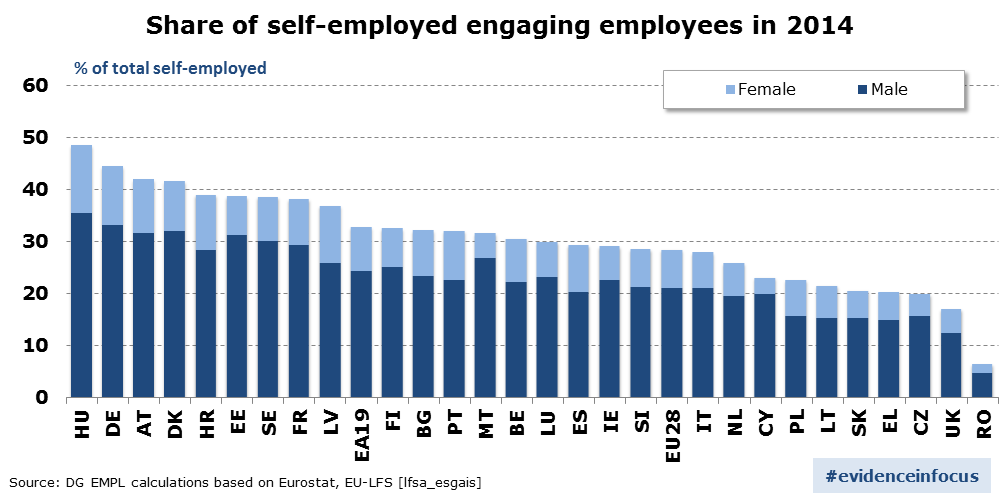Self-employed and entrepreneurship: breaking the barriers to job creation
(From ec.europa.eu)
Self-employed and entrepreneurship: breaking the barriers to job creation
© Kzenon / Shutterstock.com
Promoting self-employment and entrepreneurship is an important way of creating new jobs and enhancing the labour market opportunities for the unemployed and other disadvantaged groups.
Are Member States using the full potential of self-employment and entrepreneurship for tackling their employment challenges?
About 16% of the EU's working population were self-employed in 2014 (see also our blog post on different groups in self-employment); and micro-enterprises, i.e. companies employing 10 persons or fewer, provided almost one third of the jobs in the EU's for-profit private sector. Yet, only a minority of self-employed – on average less than one third – actually employ other people, and only about one quarter of these employers are women (see chart below).
 Source: DG EMPL calculations based on Eurostat, EU-LFS (lfsa_esgais)
Source: DG EMPL calculations based on Eurostat, EU-LFS (lfsa_esgais)
In 2014, the highest share of employers among the self-employed is found in Hungary (49%), followed by Germany (45%), Austria (42%) and Denmark (42%) – with most of them being active in whole- and retail-sale.
In Romania (6%), the share of self-employed hiring employees is exceptionally low, but this reflects the fact that more than three quarters of the self-employed are small farmers in individual farms, practicing (semi-)subsistence farming, not hiring employees.
At the same time, Spain (31%) and Poland (30%) recorded the highest share of female self-employed with employees, while Cyprus (13%) and Malta (15%) recorded the lowest share.
What barriers to expanding one's business?
Ongoing structural changes, such as technological progress, globalisation and the necessary greening of the economy will undoubtedly create new opportunities for new entrepreneurs and business expansion. Nevertheless, several labour market and social factors may hinder the full realisation of this potential (see also our blog post on who survives in self-employment).
Self-employed persons (particularly the young and women) do not always have access to finance to expand their activity and hire people due to, inter alia, a lack of collateral and high fixed costs for a loan (independent of the size of the loan ). The self-employed also often lack the entrepreneurial skills that are crucial for identifying and exploiting new opportunities, while access to entrepreneurship education is rather limited (especially for disadvantaged groups). Moreover, stringent employment protection legislation and inefficient legal systems may give rise to high firing costs which discourage the self-employed from hiring. In some countries, less stringent labour law rules apply to the smallest businesses, but this shifts the obstacle to business expansion to the threshold at which compliance with tighter regulations is required.
Women entrepreneurs especially affected
Data presented in Employment and Social Developments in Europe 2015 suggests that some groups, such as young people, women, older people and ethnic minorities, may be facing stronger barriers to expanding business.
Barriers that prevent specifically women from hiring employees include the difficulty to maintain a good work–life balance (e.g. via well-designed child-support facilities). In addition, a strong male orientation of business networks, and low participation rates in science, technology, engineering and mathematics education (subjects which tend to give access to a wide range of new business opportunities), can make it difficult for women entrepreneurs to expand their business or to thrive in sectors which offer the best chances for expansion.
While many more self-employed could probably hire employees, there will always be self-employed individuals who will be working on their own. More and more self-employed will rely on ICT innovations and internet platforms to organise their work and to acquire new assignments from customers. This could represent a pathway into self-employment for many, and notably older workers, the highly educated as well as women with children.
How to break the barriers to job creation?
Labour market and social policies have their role to play in ensuring that Europe can realise the full potential of job creation through self-employment and successful entrepreneurship, especially if more self-employed become employers. The wide range of measures that needs to be envisaged includes developing managerial skills, especially among women and young people, supporting the innovation capacity of micro and small firms, and reducing hiring and firing costs. At the same time, adequate social protection might make the step into self-employment more attractive particularly to vulnerable groups.
More details on self-employment and entrepreneurship as drivers of job creation and on policies to support them can be found in Chapter 1.1 'Boosting Job Creation through Self-Employment and Entrepreneurship' of Employment and Social Developments in Europe 2015 review.
Author: E. Meyermans works as an economist at the Thematic Analysis unit of DG EMPL.
The views expressed in this article are those of the authors and do not necessarily reflect the views of the European Commission.
Editor's note: this article is part of a regular series called "Evidence in focus", which will put the spotlight on key findings from past and on-going research at DG EMPL.